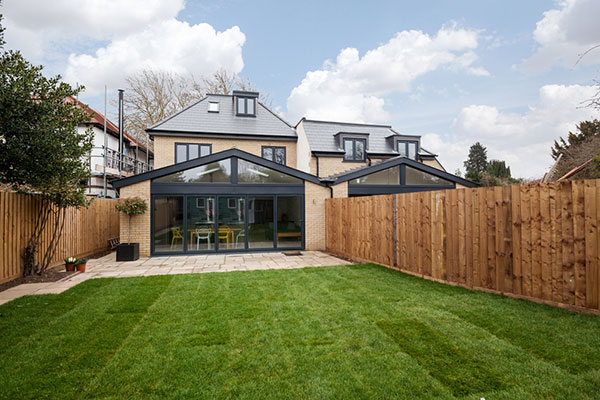Next Auction:
4/12/2025

Next Auction:
4/12/2025


From loft conversions to rear extensions, it seems like everyone is extending their homes these days. Skips and scaffolding have become permanent fixtures on residential streets across the UK. But with construction costs soaring, materials in short supply, and economic uncertainty looming, is the substantial investment of extending your home actually worth it in 2025? Let's examine the cold, hard numbers behind the nation's extension obsession.
When considering an extension, the financial equation is pretty straightforward: will the increase in property value exceed the cost of construction? However, the answer varies dramatically between location, property type, and the quality of materials.
According to Homebuilding & Renovating magazine, a well-designed extension will typically add between 5-25% to your property's value. Kitchen extensions can add around 5-10%, while an extension that adds an extra bedroom could add as much as 20%.
However, in areas where properties have already reached their ceiling price (the maximum achievable in that location), even the most impressive extension can struggle to deliver a positive return on investment.
These are perfect for semi-detached and end-of-terrace properties, utilising the often-neglected space at the side of your home. Current construction costs for a basic side extension range from £1,800-£3,000 per square metre for most of the UK, to £3,000-£4,000 in London and the Southeast.
A typical 15m² side extension would therefore cost around £27,000-£45,000, and £45,000-£60,000 in London. It could add 5-10% to your property's value, or £15,000-£30,000 for the average UK home or £25,000-£50,000 in London.
While often the most cost-effective option, side extensions typically add less overall value than rear extensions because, by their very nature, they don't usually create huge amounts of extra space.
Typical profit margin: £13,500 loss (-38%) based on average cost of £36,000 and value uplift of £22,500
Rear extensions are the most popular choice. Single-storey rear extensions typically cost between £2,000-£3,000 per square metre and £3,500-£5,500 in the capital, according to Checkatrade's 2025 cost data.
A 20m² single-storey rear extension would therefore cost approximately £40,000-£60,000, and £70,000-£110,000 in London. For double-storey rear extensions, expect to pay £80,000-£150,000 outside London and £110,000-£180,000 in the capital.
The value added can be substantial, especially when creating modern open-plan kitchen/dining spaces. Well-executed rear extensions can add 10-15% to property values, potentially delivering returns of £30,000-£45,000 for the average UK home. The greatest returns are seen in high-value areas such as London, Oxford, and Cambridge, where space comes at a significant premium.
Typical profit margin: £12,500 loss (-25%) based on average cost of £50,000 and value uplift of £37,500
Loft conversions consistently deliver the best return on investment, with costs ranging from £40,000-£65,000 for a standard conversion with skylights, to £70,000-£120,000 for more complex hip-to-gable with dormer extensions.
The regional variation is less pronounced than with ground-floor extensions, though London prices still command a 20-30% premium. The key advantage is that you're creating valuable new space without sacrificing garden area.
You can expect an uplift in value of between 20-25%, an increase of £60,000-£75,000 for the average UK home.
Typical profit margin: £15,000 profit (+29%) based on average cost of £52,500 and value uplift of £67,500
While many extensions fall under Permitted Development rights, navigating planning regulations remains a major challenge. Permitted Development rights don't apply in conservation areas, listed buildings, or areas with Article 4 Directions. Single-storey extensions beyond 4m (detached) or 3m (semi/terraced) need planning permission. Planning applications cost £206 in England, with professional fees potentially adding £3,000-£5,000, especially for conservation areas or listed buildings.
The construction will significantly impact your daily life. Based on current industry standards in 2025, expect the following build times: Single-storey rear extensions: 3-4 months; Single-storey side extensions: 3-4 months; Two-storey extensions: 5-6 months; Loft conversions: 2 months; Wraparound extensions: 4-5 months.
Temporary accommodation costs range from £800-£1,500 per month outside London to £2,000-£3,500 in the capital. Even staying put incurs costs from increased energy bills to takeout meals, and additional cleaning which can easily add £1,000-£2,000 to your budget.
Architect fees typically range from 5-12% of the construction costs, while project management adds another 15-25%. Self-managing saves money but requires time and knowledge. Most homeowners, though, find professional management delivers a better result, especially for more complex projects.
As you can see, if you look at an extension as nothing more than an investment, only loft extensions really deliver for the average home and you are currently probably better off moving. However, in the more expensive areas, it can be a very different story. In London, for example, one extra square foot of space is worth an average of £585, whereas in Cardiff, it is worth less than half that at £241/sq ft. Mind you, if you just want some more space in a home you love, those sorts of considerations are irrelevant.
If you are thinking of investing in the property market, give us a call at Phillip Arnold Auctions - 020 8799 3880. Or, to see our latest properties visit our website.
©2025 Phillip Arnold Auctions. All rights reserved.